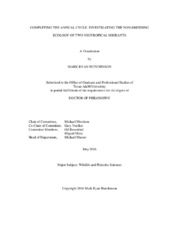| dc.description.abstract | A large majority of migratory bird research has focused on activities on the breeding grounds, but migratory birds spend most of the year engaged in non-breeding activities. To complete some of the knowledge of each bird’s annual cycle, I conducted research on the non-breeding ecology of two federally endangered neo-tropical migrant songbirds, Golden-cheeked Warbler (Setophaga chrysoparia) and Black-capped Vireo (Vireo atricapilla), that breed in the Texas hill country.
After breeding but before migration, researchers have observed Golden-cheeked Warblers using vegetation different from their breeding vegetation of oak-juniper woodland. To determine vegetation associations during the post-breeding period of 2010-2012, I conducted surveys at 34 locations composed of breeding vegetation in the low stony hill or redlands eco-sites and the immediately adjacent non-breeding vegetation made of oak woodland, oak savannah, or riparian strips. Warblers used breeding vegetation more commonly than non-breeding vegetation. Among detections in breeding vegetation, I found warblers most commonly in the low stony hill eco-site which is considered to be the highest quality eco-site type based on breeding success. When I found warblers in non-breeding vegetation, they were most often in riparian strips and oak woodlands adjacent to the low stony hill eco-site. Neither canopy cover nor territory density had a significant relationship on detection rate during the post-breeding period. When I found warbler groups, they were most commonly composed of family groups or lone males that were foraging. These results indicate that, while Golden-cheeked Warblers do use vegetation other than breeding vegetation during the post-breeding period, high quality breeding vegetation remains the most important vegetation type to these birds during this period of their annual cycle.
To determine the migratory connectivity, the degree to which breeding population structure is maintained on the wintering grounds, of Black-capped Vireos I collected feathers from 158 vireos across their breeding range in Texas and Oklahoma from 2010-2012. I analyzed stable hydrogen isotope composition in vireo feathers to establish a breeding range map to which others could compare feathers collected from birds on the wintering grounds. I found that, unlike most migratory bird species, Black-capped Vireo feather isotope ratios patterns do not match rainfall isotope ratio patterns. This species’ feathers also do not follow patterns of groundwater hydrogen isotope ratios. Due to extreme variability of feather hydrogen isotope ratio, I was unable to use a stable isotope analysis to establish a functional breeding ground isotope map for use by other researchers. Other techniques are necessary to determine this important aspect of Black-capped Vireo’s annual cycle. | en |


